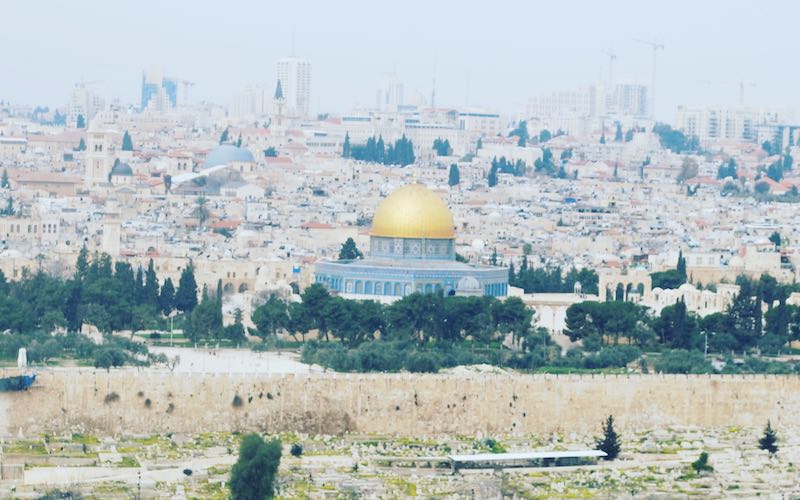Israel is one of my favourite destinations mainly because of its history and religious diversity. Jerusalem is a city not to be missed, of course, but Tel Aviv was also a very pleasant surprise for me. If you only have 3 days in Israel, this blog will help you to make the most of your time there. I have included plenty of travel advice and also a 3 day itinerary that includes one day in Tel Aviv (where you will probably fly in to) and two days in Jerusalem.
What is the best time to visit Israel?
I visited Easter in early April and it was the perfect time to go – temperatures were not too hot for sightseeing and I also avoided the crowds and religious tension that can occur around Easter time. Overall, the best time to visit Israel is the spring (April-May) or Autumn (September-November). You will also need to consider Jewish holidays (they can be busy) and other religious festivals that may impact on how busy it is in Jerusalem (and also religious or political tension fuelled by certain celebrations).
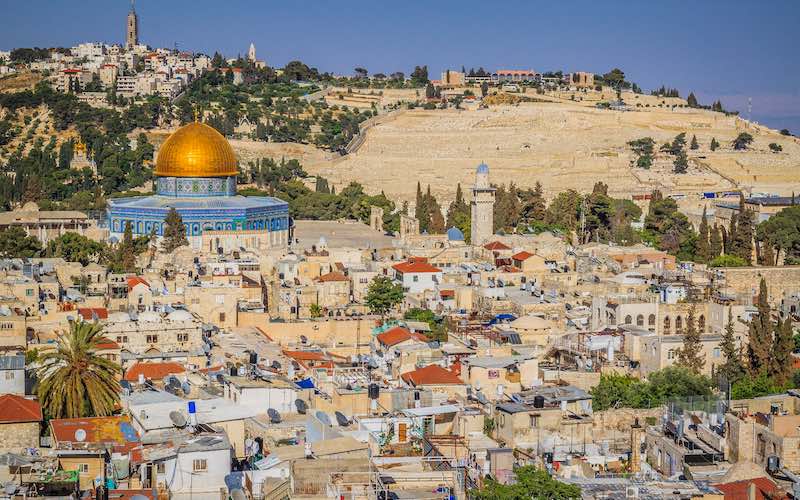
How many days in Israel – Is 3 days in Israel enough?
I would argue that 3 days in Israel is not really enough – I would recommend at least 5 days to explore Tel Aviv and Jerusalem, and if you are a culture vulture (like me) then you could easily spend a week! I would say that you need 2 days in Tel Aviv and a minimum of 3-5 days in Jerusalem. However, if you are passing through Israel for connecting flights or have very limited travel time, then you will be surprised at how much you can actually see in Israel in just 3 days.
A few words of advice about visiting Israel
- Israel has standardised on type H sockets and plugs – take an adapter with you. The new C type plugs (the ones with 2 pins) will probably work in Israel also.
- Israel is expensive – you can change money to Israeli Shekels before you go. Take plenty of cash and also a backup credit card.
- Religious and Political tensions can be high particularly around certain festivals so check these before booking.
- Look on the Foreign and Commonwealth office (or your country’s government travel website) for the most up to date advice on whether it is safe to travel to Israel.
- Don’t be surprised about seeing young people (men and women) in the army and carrying guns – National military service is mandatory for all Israelis over 18.
- Kosher food laws will often apply in Israel and even begin on the flight to Tel Aviv. Have a read up on the kosher food laws and don’t expect to get a ham and cheese sandwich!
- Show respect to all religions – Jerusalem itself has a Jewish quarter, a Christian quarter, a Muslim quarter and an Armenian quarter. It is worth learning about the customs, practices and festivals for each of these before you travel. For example, be aware that Muslims will be fasting during Ramadan.
- If you are on a limited time period such as 3 days in Israel, don’t try to pack too much in at the expense of enjoying the Israel experience. Pace yourself and take it easy!
- Download the GettTaxi app – For cheap taxis in Jerusalem (the Israeli alternative to Uber).
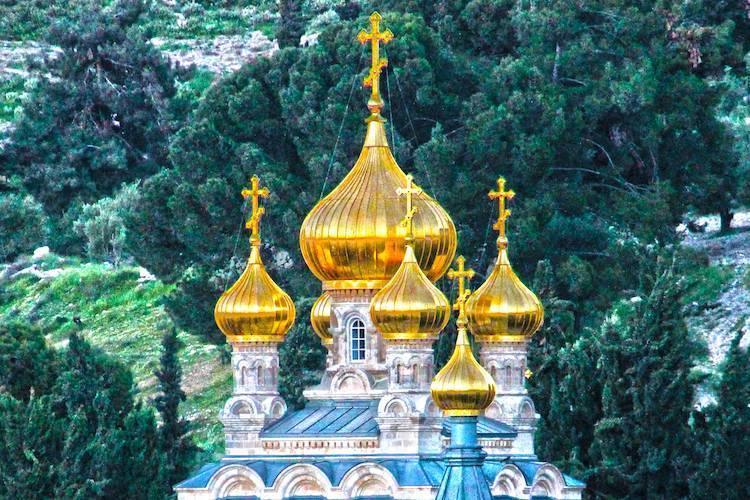
It could be worth mentioning that I got questioned in Tel Aviv Ben Gurion airport when I visited in 2017 for the TBEX conference. I made the mistake of having my journalist badge on display and this was exacerbated by the fact that I had a lot of Arabic stamps in my passport (Morocco, Tunisia and Turkey). This is why many people who travel to Israel and other middle eastern countries have two passports – one that they use for Israel and another used for Arabic speaking countries in the Middle East. In the rare event that you get pulled for questioning in Israeli airports, you should co-operate willingly when asked for your bags (which they may go through) and answer all questions immediately with honesty and politeness.
What to pack for Israel
If you are looking for advice on what to pack for Israel, here is a list of essentials…
- Light but conservative clothing as there are a lot of religious buildings to see in Jerusalem – Linen or cotton trousers and long sleeved t-shirts or long sleeved linen tops are perfect.
- Sturdy walking boots – there is a LOT of walking to be done if you have just 3 days in Israel.
- Sandals or flip flops for second pair of footwear on hot days and for Tel Aviv beach.
- Shawl or scarf which can be used to cover your head in Mosques, protect your head from the sun and also can be used as a shawl to keep you warm on cooler evenings.
- A paperback guide book such as the Lonely Planet Israel & the Palestinian Territories for ideas, maps and to read if you have slow wifi.
- Israel Power Adapter – the power outlets are 230V/50Hz, and type C and H power sockets.
- Padlocks or luggage locks for use in youth hostel lockers or to lock your bags at airports.
- One trendy evening outfit with comfortable flats – there is a great nightlife scene in Tel Aviv that you might like to enjoy, or dress up nice for a meal out in Jerusalem.
Getting around in Israel
Trains do link Tel Aviv airport and Tel Aviv centre. Trains also link Tel Aviv and Jerusalem, but the train station in Jerusalem is quite far out of the city and so bus is recommended for travel between the two main cities. Jerusalem central bus station is located on Jaffa Road near the entrance to the city. If you want to use taxis I would recommend that you download the GettTaxi app which is basically the Israeli version of Uber. You will know what the registration of your taxi is and what price you will pay (roughly) in advance.
What to avoid in Israel
Israel is an amazing destination, packed full of religion and culture to the extent that just 3 days in Israel will certainly leave you wanting more. However, as with any destination, there are certain things that you should avoid.
- Avoid walking around the Old Town on Jerusalem at night and check with locals where it is safe to do so.
- Avoid political protests and demonstrations around Damascus Gate – they can get violent very quickly and Israeli police do carry guns.
- Avoid areas in the old town of Jerusalem at times of tension – you can usually tell when something is going down in Jerusalem because the shop keepers will suddenly start packing up and pulling down the shutters on their shop. When this happens it’s time for you to scarper.
- Damascus Gate area and the city walls are areas where single female travellers have been targeted by male gropers – avoid doing these areas alone if possible.
- Avoid heading into Palestine without checking with locals and going with a guide. It may be safe to visit destinations such as Hebron at your time of travel, but do it with a guided tour accompanied by someone who knows Israel well.
- Avoid eating out all of the time – Israel is not cheap! I would recommend that you stay somewhere like Abraham Hostel where you have access to a kitchen for some self catering meal prep.
- Avoid looking suspicious and having a passport with lots of Arabic speaking countries stamps – you may get pulled over for questioning (read my blog about the time I got pulled for questioning at Tel Aviv airport).
- Avoid packing your drone – you will NOT be allowed to enter Israel with it or use a drone in Israel.
- Avoid travel to the Gaza strip and also avoid areas that are highly religious neighbourhoods where conflict is more likely.
- Avoid walking or driving through the Jewish Orthodox area of Jerusalem (Mea Shearim) on the Sabbath.
- Avoid having visible evidence of being a journalist on display – particularly when passing through the airport.
2/3 Day Itinerary – at a Glance
- Day 1 – Tel Aviv: Carmel Market, Great Synagogue, Jaffa and Gordon Beach or Frishman Beach
- Day 2 – Jerusalem Old Town: Old Town of Jerusalem including Dome of the Rock, Church of the Holy Sepulchre and the Western Wall. In the afternoon explore the Mount of Olives.
- Day 3 – Mount Zion and New Jerusalem: In the morning see the sites of Mount Zion – Dormition Abbey, the room of the last supper and King David’s Tomb. In the afternoon head to the New Town of Jerusalem to check out the Shrine of the book and Mahaneh Yehudah Market.
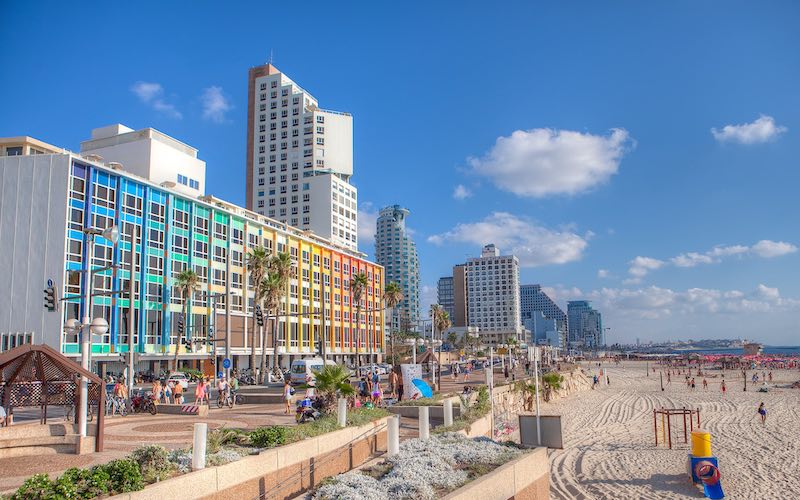
Detailed 3 Days in Israel itinerary
This detailed itinerary allows you to spend 1 day in Tel Aviv and then another 2 days in Jerusalem. Jerusalem is one of the most religious and culturally diverse cities in the world and there are a lot of important sites in the Old Town that you won’t want to miss. I would advise that you travel from Ben Gurion airport to Tel Aviv by train on the first morning in Israel (or the night before). The take a bus from Tel Aviv to Jerusalem (the bus station in Jerusalem is more accessible than the train station which is further out of the city) on the evening of the first day (or if you want to go out in tel Aviv the morning of Day 2).
If you can stretch your trip to four days you can allow yourself to spread the sightseeing out a little and pencil in a travel and leisure day.
Day 1 – Tel Aviv
Tel Aviv: Carmel Market, Great Synagogue, Jaffa and Gordon Beach or Frishman Beach
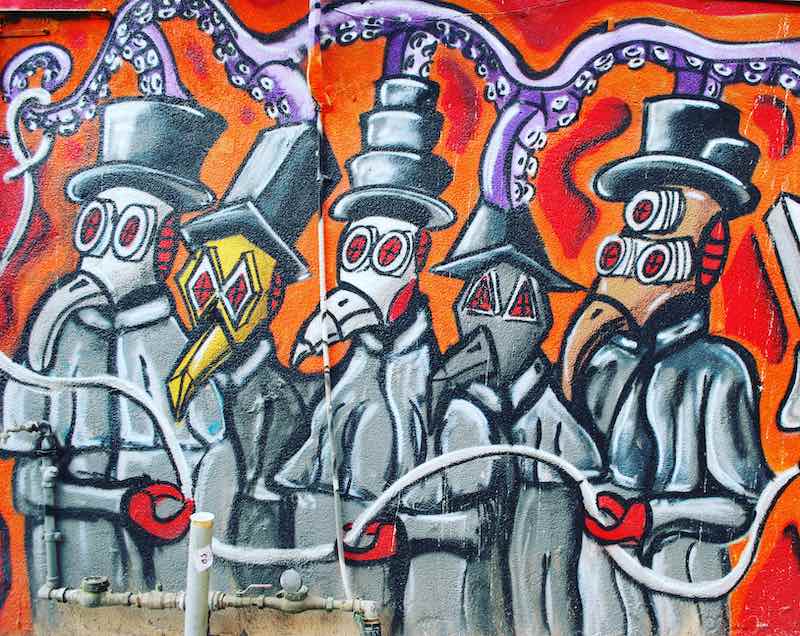
Carmel Market and the Great Synagogue
Start your day by heading to Carmel Market, where you will be able to explore numerous bohemian craft stalls and enjoy Tel Aviv’s street art. From there you can walk to the Great Synagogue – one of the largest Synagogues in the world. It is an Orthodox Synagogue built in 1922.
Jaffa – Old Town of Tel Aviv
Jaffa, the Old Town of Tel Aviv is around 4km South along the coast from central Tel Aviv. It is a beautiful coastal walk (if your legs can take a full day of walking!) but if not, consider jumping on a rental bike or electric scooter. It’s a relaxing route to take however you choose to travel.
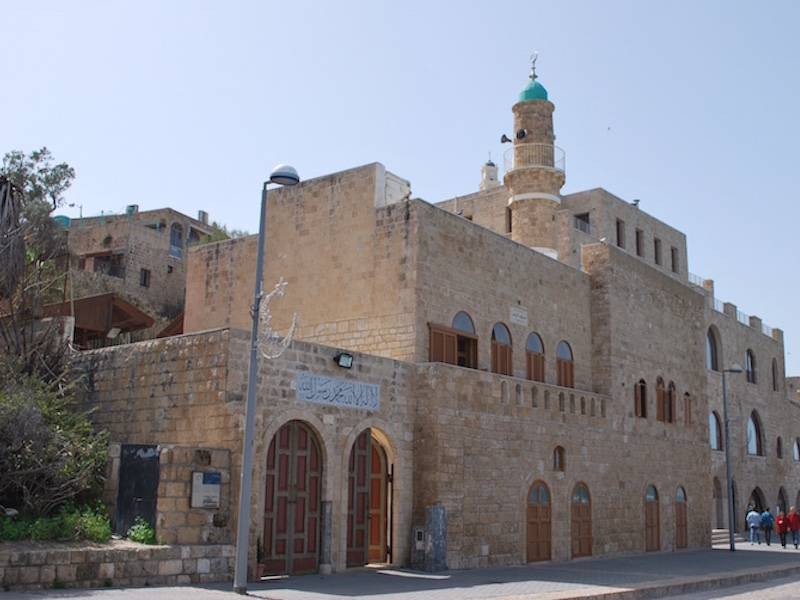
In Jaffa, you will see a beautiful seafront and harbour with historical buildings such as mosques, the clock tower and various Churches (including an Armenian Church and monastery). Also don’t miss Jaffa flea market and St Peter’s Church.
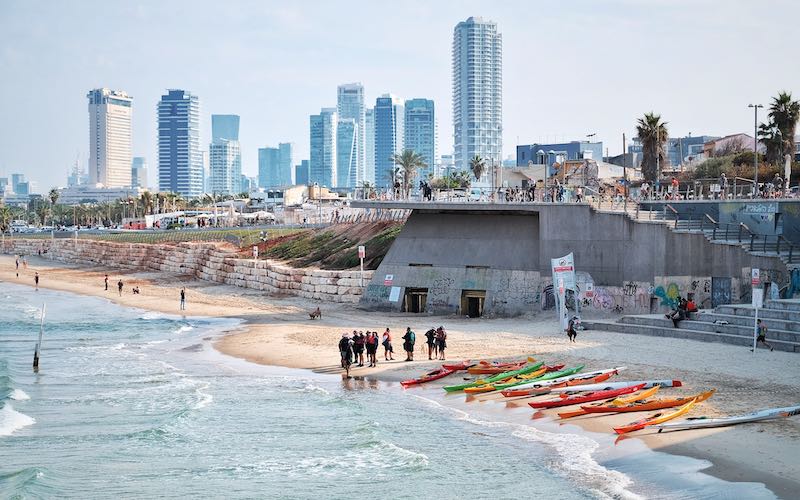
Head to the Old Jaffa lookout point to get fantastic photos of Tel Aviv bay. It can get busy at times, so you may have to wait for a spot!
Relax on Tel Aviv beaches
Tel Aviv has some fantastic beaches including Gordon Beach and Frishman Beach. the beaches in Tel Aviv are sandy and well resourced, with toilets, showers and bars/coffee shops. Banana beach is also popular with tourists. Below is a map showing the locations of the best beaches in Tel Aviv.
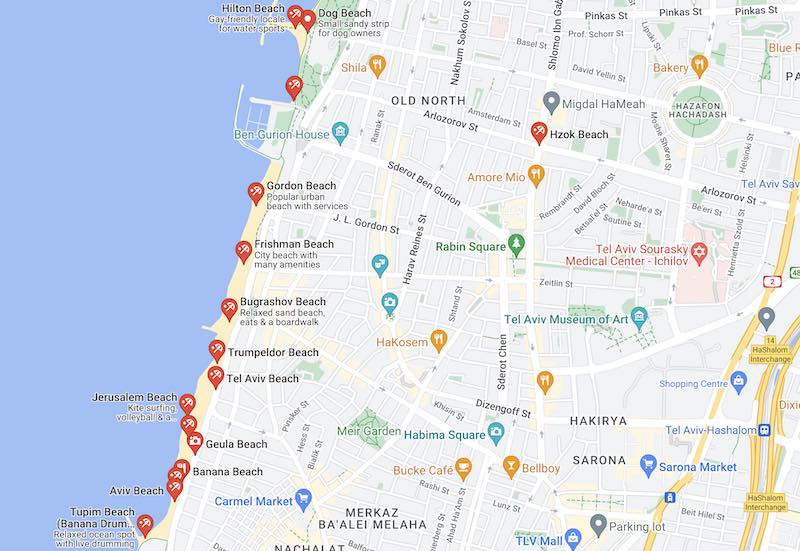
If you are not completely exhausted after all that, why not immerse yourself in the amazing Tel Aviv nightlife scene? Tel Aviv is very liberal and supportive of LGBTQ communities. Some of my favourite bars in Tel Aviv are Bellboy and Kuli Alma. If you are up for a night of clubbing, check out The Block, Alphabet or Radio EPGB.
Head to Jerusalem by bus for the next leg of your itinerary.
Day 2 – Jerusalem Old Town and Mount of Olives
On day 2 it’s time to explore one of the most culturally rich and religiously diverse cities in the whole world – culture vultures (like me!) are really in for a treat here. Be warned – this is A LOT to fit in one day and so if you can spare an extra day here in Jerusalem, please do!
Jerusalem Old Town
The Old Town of Jerusalem is approximately 1km x 1km and is a UNESCO World Heritage Site that is explorable on foot. Jerusalem Old Town is divided into four quarters – the Armenian Quarter, the Christian Quarter, the Jewish Quarter, and the Muslim Quarter. I would recommend heading straight to the Dome of the Rock and Western Wall first (and very early) as there are often big queues. Do this early around 8-9am and then explore the four quarters. The most interesting sites in Jerusalem Old Town include….
- Dome of the Rock – The Dome of the Rock is a shrine built on the highest point at Temple Mount in the Old city of Jerusalem. It is important to Muslims as it is said to be the location where the Prophet Muhammad (pbuh) ascended to heaven (night journey). Dome of the Rock is also sacred to Jews as it is said to be the navel of the world and the point where Abraham was to sacrifice Isaac. Non-Muslims (including Jews and Christians) can enter as tourists at certain times.
- Western Wall – This is the remaining Western Wall of the old Jewish temple built by Herod. It is a Jewish place of worship and many Orthodox Jews insert scrolls into the wall which contain prayers written in Hebrew.
- Church of the Holy Sepulchre – One of the holiest Christian churches in the world, the Church of the Holy Sepulchre houses the tomb of Jesus Christ himself and is a pilgrimage destination for Christians from all over the world.
- Al-Aqsr Mosque – Al-Aqsa Mosque is the black domed mosque located south of the Temple Mount near the Ark of Shlomo. It is the third holiest site in Islam.
- Hurva Synagogue – The greatest Synagogue in the Old Town of Jerusalem which is built as a testimony to the Ashkenazi Jews coming back to Israel.
- Tower of David – Jerusalem’s citadel that is a medieval fortress. It is of international significance and is the historical entrance to the Old City.
- Via Dolorosa – One of the most significant streets in Jerusalem for Christians is Via Dolorosa, the street down which Jesus carried his cross before he was crucified.
- The Cardo – Ancient Jewish thoroughfare where you will find market stalls and Jewish eateries. Part of the Cardo appears as it would have in Roman times.
- Arabic Souk – Stepping into the Arabic souk almost feels like you have teleported to Morocco! It spreads from the Muslim quarter to the Christian quarter and sells fabrics, ceramics and souvenirs.
Mount of Olives
These above Old Town destinations should fill most of your day, but if you find yourself with spare time and are not yet flagging, consider continuing to the Kidron Valley and Mount of Olives. If you are heavily into religion and culture like I am then the Kidron Valley and Mount of Olives are likely to spill over into your second day. Some highlights include:
- Chapel of the Ascension – Church built on the spot where Jesus ascended to heaven.
- The Church of Dominus Flevit – A Church built on the site where Jesus was said to be weeping in the Garden of Olives before his crucifixion.
- Church of Mary Magdelene – Russian Orthodox Church built in 1886 by Tsar Alexander with seven beautiful golden guilded domes. The Church is dedicated to Mary Magdalene, one of the followers of Jesus.
- Tomb of the Virgin Mary – The Tomb of the Virgin Mary, mother of Jesus Christ.
- Basilica of the Nativity – At the foot of the Mount of Olives, this Church with a beautiful interior roof is significant to Christians as the birthplace of Jesus. In the grounds of the Church you will find the Garden of Gethsemane, where Jesus Christ underwent the agony in the garden and was arrested before being crucified.
If you don’t have time to see all of the Mount of Olives, prioritise the Basilica of the Nativity over everything else there.
Day 3 – Finish Old Town Jerusalem, see Mount Zion and visit New Jerusalem
As 3 days in Israel is a very limited amount of time, you may decide to skip the Mount Zion section of the itinerary if the sites of Jerusalem Old Town and Mount of Olives spill over into your second Jerusalem day. Alternatively, if religion and history are more important to you than the New Town of Jerusalem, then you may choose to skip New Jerusalem in favour of continuing with the Old Town.
However, the New Town is a very interesting contrast and you can get a good feel for it in an hour or two. I would recommend that in the New Town you see Mahaneh Yehudah Market at least.
Mount Zion
Mount Zion has a few sites of religious and historical importance. If you don’t have time to see it all, then I would recommend that you prioritise seeing the room where The Last Supper took place. Here are the highlights of Mount Zion…
- Dormition Abbey – a German-Catholic Church built where Mary (Mother of Jesus) was said to have lived and laid to rest.
- Room of the Last Supper – The Upper Room is the place where Jesus is believed to have had his last meal with his disciples before his death.
- St Peter Gallicantu – A Roman Orthodox Church with a Blue Dome that was built on the spot where Jesus was imprisoned and represents the denial of Peter (before the cock crows twice, you will deny me three times. Mark 14:30).
- King David’s Tomb – The Tomb of King David is a Jewish Pilgrimage site. There is debate as to whether it actually is King David’s resting place or is simply associated with the burial of the biblical King David, but either way it attracts Jewish pilgrimages from all over the world.
Modern Jerusalem
After that, head out of ‘New Gate’ towards the new town of Jerusalem past Zion Square. This is the new area of the city and Mehane Yehuda market is known as the heart of Jerusalem. It’s a completely different feel and much more modern than the Old Town, with a sophisticated tram system and numerous hotels and university buildings. When you are in the modern part of Jerusalem, don’t miss…
- Mehane Yehuda market – A market full of snacks, spices and souvenirs, with shutters that reveal quirky street art when pulled down.
- Shrine of the book – A shrine in the Israel Museum (Givat Ram neighborhood) that is home to the Dead Sea Scrolls and the Aleppo Codex.
- Yad Vashem – Memorial and museum dedicated to the survivors of the Holocaust, including exhibitions with accounts from survivors and honouring Jews who were murdered.
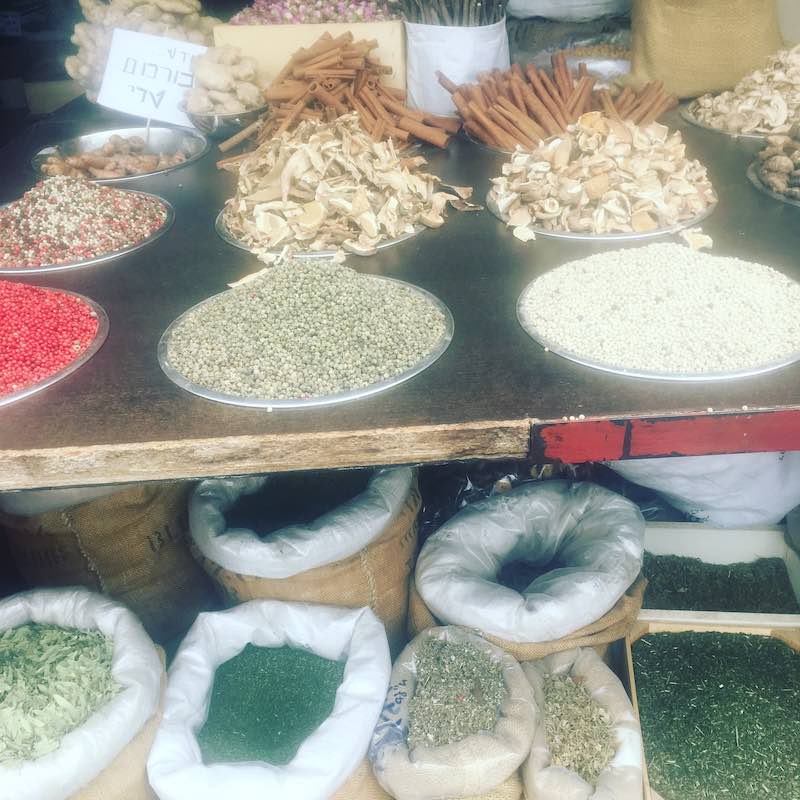
Additional Activities – Continuing your Journey
If you are lucky enough to get more time in Israel, there are a few other things that I would definitely recommend. In Jerusalem, the City of David is fantastic to see and you get to explore the labarynth of underground tunnels. Also, a day trip to Masada and the Dead sea is one of the best day trip experiences in Israel. This ancient fortification is built on a rock in the dessert and was where King Herod the Great built his palace.
Where to stay in Israel – hotels and hostels
- Abraham Hostels – Great value and perfect for solo travel. There is one in Tel Aviv and Jerusalem so you can travel between both.
- Dan Hotels – I highly recommend any of these hotels including the Dan Jerusalem Hotel and Dan Boutique hotel.
- Walled off hotel – Famous quirky Banksy themed hotel built overlooking the wall between Israel and Palestine.
Further Reading on Israel
If you enjoyed this blog on spending three days in Israel then you might also like to read:
- How to spend 2 days in Tel Aviv.
- Solo Travel Israel – The Ultimate Guide
- Is Israel Safe for Solo Female Travellers.
- How to plan the perfect Jerusalem Vacation.

